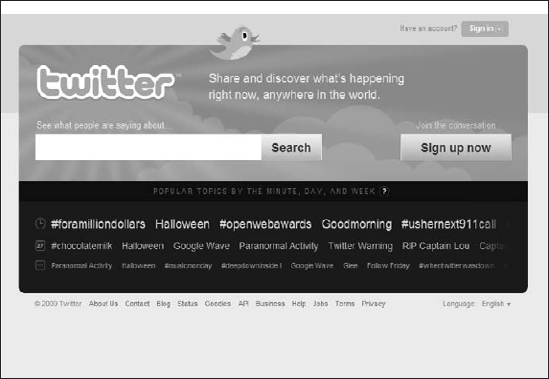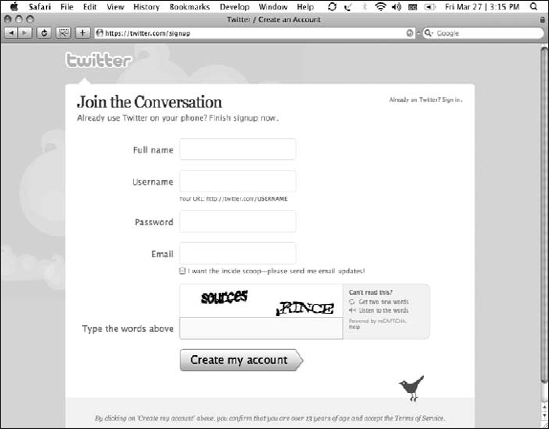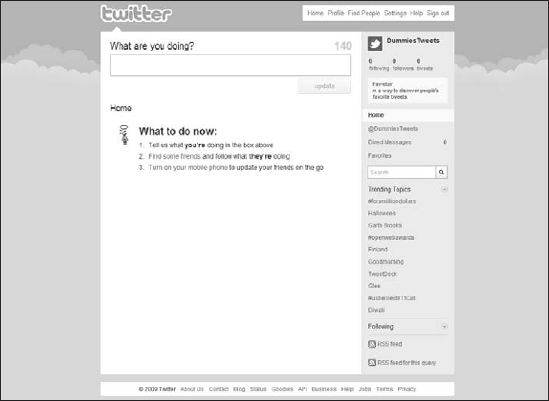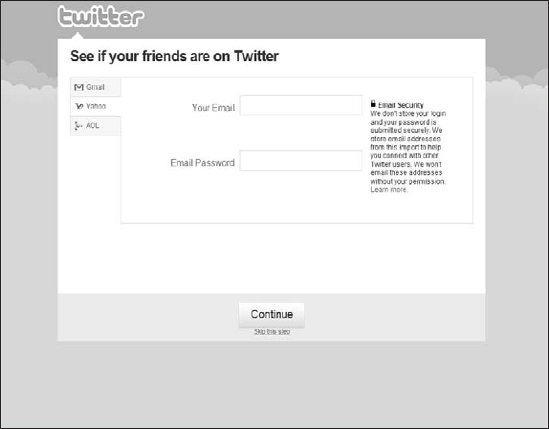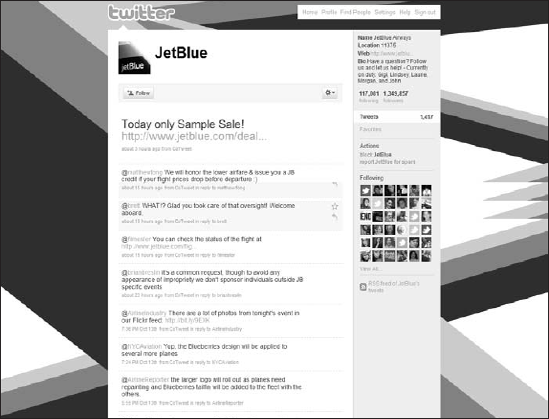Getting your Twitter party started
Coming up with a good Twitter name
Mixing it up: Making friends and saying hi
Standing out with a unique Twitter profile
Getting SMS tweets on your cellphone (or not)
Twitter is a deceptively simple, yet powerful conversation tool that enables users to broadcast short messages to the world and to connect more closely with people they care about. Intrigued about why this "stupid"-looking tool is so well-loved and popular? Then this chapter is the place to get your feet wet. It usually takes a while of using Twitter to get what about it could be really interesting and valuable to your life. Luckily, Twitter is not only easy to use, but it's also quick to set up and a piece of cake to get going.
In this chapter, we go over the very basics of Twitter: getting a username, beautifying your profile, finding people to communicate with, and getting yourself situated and ready to start tweeting like a pro in no time.
For many Web services, signing up is the easiest part of an otherwise complicated process. With Twitter, using the site is just as easy as signing up.
To sign up for a Twitter account, follow these steps:
Use your Web browser to navigate to the Twitter Web site at
www.twitter.com.The Twitter splash page appears, as shown in Figure 2-1.
Click the large green Get Started — Join! button.
The signup page appears, as shown in Figure 2-2.
Enter your desired username and basic information in the appropriate text boxes.
The only information Twitter requires from you is a username, a password of your choice, and a unique e-mail address where Twitter can contact you for notifications. (You'll probably take longer to decide on a username than to actually sign up. We cover how to choose a good Twitter name in the following section.)
Type the CAPTCHA code in the Type the Words Above text box.
This step is a standard Web tactic to prove that you're a human and not a spam program. (For more information on this code, see the sidebar "What's up with the CAPTCHA?")
Click the Create My Account button.
Note
By clicking the Create My Account button, you're agreeing to Twitter's Terms of Service. You see a link at the bottom of the page where you can read those Terms of Service if you like, or you can go to http://twitter.com/tos to read them.
You're taken to your newly created Twitter account (see Figure 2-3).
Note
Tip
Did you know you can register for Twitter entirely by text from any cellphone? Get a friend started while you're away from a computer — you can create a new Twitter account from any cellphone at any time. Just send an SMS text message with the word "join" to 40404 and follow the directions that are texted back to you to choose a username. Later, go to Twitter.com and look for the button labeled Already Using Twitter from Your Phone? Click Here. (To find out more about using Twitter on your cellphone, check out section "Adjusting Your Text-Messaging Settings," later in this chapter.)
If you already have a Twitter account, do not text "join" to 40404 or you will lock your phone into a separate new account. You will not be able to add your phone to your original account until you delete the new one. See instructions on how to set up your phone to work with your existing Twitter account later in this chapter, in the section "Adjusting Your Text-Messaging Settings."
On Twitter, your username is your identity. Laura's Twitter name, or handle, is @Pistachio, and it has become the way that many people know her. She's met thousands of people in real life after initially connecting with them through Twitter, and it's not unusual for her to hear, "Hey, Pistachio!" from across the street or across the room at a party. @Pistachio has, in effect, become her nickname. If you want a quick glimpse at the search engine "optimization" (SEO) value of Twitter, just run a Google search for the word pistachio and you'll find her Twitter account is one of the very first search results. Crazy.
Note
When we refer to Twitter usernames in this book, we follow the convention of putting an at sign (@) before the name, because that's how you refer to other users on Twitter. (For example, if you want to say that you're reading Laura's book, you might say, "Reading @Pistachio's book." That way, people who follow you on Twitter can easily click over to Laura's Twitter profile, in case they want to follow her, too!) But when you're actually choosing a username, the @ isn't part of it. The only characters you can use are uppercase and lowercase letters, and the underscore character (_).
That story emphasizes that you should think about how you want to be perceived both on and off Twitter and how your username fits into that perception. Twitter is a far-reaching service, and if you get really involved in the culture of Twitter, like the rest of the social Web, it undoubtedly spills over into real life. The days of choosing anonymous handles such as sexybabe44, like you may have when you used instant-message programs or chat rooms in years past, are long gone.
Tip
If you can sign up for Twitter by using your name or a variation of it as your username (assuming somebody else isn't already using it), we recommend doing so. It makes your experience with Twitter much easier when the line between online and offline blurs.
For example, if your name is John Ira, you may want to pick a Twitter username such as @johnira or @john. If users have already claimed those monikers, try adding an adjective or descriptor, such as @handsomejohn or @johntheterrible. If you prefer for people not to know who you are, you can choose a name that's a bit more generic. You can also use a handle that you've established on other Web sites. You may also want your username to match your e-mail address — for example, if your e-mail address is [email protected], you may decide to use @doglover1980 as your Twitter name.
Tip
Be forewarned! If you choose to use your last name only, like Michael (@gruen), you may find yourself without a first name in the eyes of other twitterers.
Using Twitter for your business? You can use your company or business name as your username, and you can fill in that business name in the Name text box on the Settings page for your account. But if you do, be sure to include the names of anyone who handles the company Twitter account in the 160 character "Bio" text box on the Settings page for your Twitter profile. (We cover how to customize your profile in the "Customizing Your Profile" section, later in this chapter.)
If you're looking to be a bit more removed and really would prefer to use a nickname rather than your name, or your company or product name, be sure to choose a username that's friendly and accessible. On Twitter, you want people to respond to you, not be put off by a risqué or otherwise questionable handle. And if you run into your Twitter pals at networking events or other real-life social situations, you want to make sure that you don't mind having your username written on your nametag or shouted out in greeting.
Tip
Lean toward using a short Twitter username. Remember: Tweets are only 140 characters, so when people are replying to you, if you have a longer name, you leave them less room for message content. Twitter limits your username to just 15 characters for this very reason. (For more on how to reply to another person on Twitter, turn to Chapter 5.)
When you first sign up for Twitter, you're prompted to see if your friends are on Twitter (see Figure 2-4). Finding contacts on Twitter can be a lot of fun! The easiest way to find your friends is to import your friends and contacts from other services that you already use (such as Gmail, Yahoo! Mail, AOL, and Hotmail). You may be pleasantly surprised at how many people you know who are already busy tweeting away.
To import contacts and make them part of your Twitter world during the registration process, follow these steps:
Select the e-mail account type from which you want to import on the left-hand side of the screen.
Type your e-mail credentials (username and password) in the Your Email and Email Password text boxes.
Warning
Having Twitter automatically find your contacts involves entering your e-mail account password. Although Twitter has established itself as a trustworthy service, in general, be very cautious about sites that ask you for your e-mail address and password.
Click the green Continue arrow.
Twitter looks at your contact list from your e-mail account and gives you a list of all the people from your address book who are already on Twitter.
Select the check boxes for the people you want to follow.
If you click the Select All check box, everyone is selected. If you uncheck the Select All check box, everyone is unselected, and you can go through your list of contacts, picking and choosing who to follow.
Note
When you follow people on Twitter, you see their updates on your Twitter Home screen.
When you finish selecting people, click the green Continue button.
If you didn't select all the people in your address book, you're asked whether you want to invite any of the people you didn't select to join Twitter. (For more on inviting people to join Twitter, see "Inviting Contacts," later in this chapter.)
Repeat these steps for all your other networks, if you have them.
Tip
If you skip this step during the registration process, you can always search for people by first name, last name, or e-mail address by clicking the Find People link at the top of any Twitter page.
Jumping into random conversations is a great way to find like-minded Twitter users, but it's not the only way. You can use a few tools to discover people on Twitter who share your interests or live near you.
One of the more interesting tools out there, TwitterLocal (www.twitterlocal.net), helps you find Twitter users by geographic location. It's a great way for people interested in real-life meet-ups, as well as those in localized industries (such as real estate and car sales) who use Twitter to drum up business, to contact each other.
Twellow (www.twellow.com) is another handy tool for widening the scope of your Twitter universe (which, yes, some call a twitterverse). Twellow sorts Twitter users by categories based on keywords found in the Bio sections of their profiles. Users can also claim Twellow profiles for any Twitter usernames that belong to them, by proving who they are. Claiming lets you edit the entry to add more categories or remove incorrect categories. Twellow is searchable by name, location, or category, similar to an online yellow pages for Twitter (hence the name Twellow).
Part III explores more of these third-party tools.
Twitter also has its own search engine, known as Twitter Search, which you can access by clicking Search at the bottom of any Twitter page or by going to http://search.twitter.com. You can enter any keyword of your choice into the Twitter Search text box and click the Search button, and Twitter not only brings you results in chronological order (with the most recent at the top), but also lets you know when people have made new tweets that match your search criteria and gives you the option to refresh the search results page.
Tip
You can use Twitter Search to find new people on Twitter by typing keywords connected to your interests or profession in the text box. Bonus: Because Twitter Search sorts results based on how recent they are, the people you discover through this search are likely very active Twitter users.
Note
Twitter Search was originally built by another Web startup called Summize, which had earned special privilege and access to Twitter's application program interface (API) to create a search engine for the microsharing service. Although Twitter officially acquired Summize and has since renamed it Twitter Search, Summize is still known to many (and affectionately referred to) by its original name. (Michael somehow never got over the name change, and Laura's been caught referring to Summize in her speeches frequently.)
During the registration process, after you import your contacts from your e-mail address book, you have the option to invite any of your contacts who aren't yet using Twitter.
The process is really simple:
On the Why Not Invite Some Friends? screen (see Figure 2-5), select which of your contacts you'd like to invite to join Twitter.
Click the green Invite arrow.
An invitation to join Twitter will be sent to the people you selected, letting them know that you're on Twitter and they can follow your updates by signing up for Twitter themselves.
If you've used the Find on Other Networks tool, you've already been prompted to invite friends from your address book who aren't on Twitter. If you want to invite your friends by hand, without having Twitter go through your address book, take the following steps:
On the top navigation bar of any Twitter page, click the Find People link.
The tabbed navigation loads below the navigation bar.
Click Invite by Email.
A text box appears.
Enter the e-mail addresses of the people to whom you want to send an invite.
Separate each e-mail address with a comma and a space.
After you enter all the addresses you want, click Invite.
You're done!
If you choose not to do this now, you can always go back and do it later. Simply click Find People in the toolbar at the top of your Twitter profile to make the input screen for e-mail invitations appear.
If you don't opt to invite people during the registration process, or you want to invite people down the road, you can always e-mail people you know whom you think would most enjoy or benefit from Twitter, sending them a link to your Twitter profile and writing a note explaining what Twitter is. Many people choose this approach when they first join Twitter so that they can keep the invitation process personal.
Tip
Many Twitter users, co-author @geechee_girl included, have put Twitter handles on business cards and in e-mail signature lines. These actions are indirect invitations for the people who meet us in real life or interact with us in business to connect with us on Twitter, as well. The more people who join you on Twitter, the more effective your network becomes.
The entire premise of Twitter is to answer the question "What are you doing?" in 140 characters or less. So, go ahead! Tell Twitter what you're doing right now. Type a message in the What Are You Doing? text box, keeping under the 140-character limit. When you're done, click Update. Congratulations! You've just made your first tweet.
If you're thinking, "Wait, that's it?" you're right: That's it. Tweeting is that simple, but that simplicity makes it powerful. Your first tweet was probably something mundane, such as, "Trying out this Twitter thing" or "Hello there, Twitter. I'm reading Twitter For Dummies!"
But while you start to add more and more updates, people begin to see what's going on in your life and what you're thinking about. Twitterers following you or searching for keywords in Twitter, in all likelihood, start talking to you about what you're doing. The conversation starts with those simple exchanges: Talk about your favorite band's new album, your mechanic and how she fixed your car's catalytic converter, or really anything at all. If you've already found your contacts on Twitter, they probably respond to you pretty quickly. If you don't have any followers yet, don't worry; they'll come.
We discuss suggested Twitter etiquette, culture, language, and all that stuff in Chapter 7. This chapter simply tells you how to get your Twitter profile up and running so that it reflects who you are and what you want to get out of Twitter.
Warning
Your tweets, right now, are publicly visible and searchable, even if you delete them immediately after hitting Update. This situation isn't life or death, but be careful. If your updates are unprotected, what you tweet ends up in Twitter Search and on Google, even if you delete it quickly. (Chapter 9 discusses search tools in depth.)
Your public page on Twitter, also known as your profile, is other Twitter users' first impression of you, and it can make a big difference in whether they decide to follow you. Take a few minutes to dress it up a little! Making sure that it reflects you or your business makes all the difference when it comes to whether people stick around to see what you have to say.
After you sign up for Twitter, one of the first things you should do is personalize your profile. Make sure that you have
An avatar (a picture that shows up to the left of your tweets, representing you or your company)
A background image or background color for your home page
A bio that's 160 characters or less
A link to anything else you want to share
Tip
Some of the best profile pages on Twitter are the ones that give you a look into that user's personality. Someone who loves to ski might upload an image of his favorite mountain range as the profile background and pair it with an avatar that depicts him in ski goggles. You don't have to bare your soul, but people on Twitter want to know something about you, and the public page is where they can first discover it.
Note
After you log into Twitter, you can customize your profile at any time by clicking Settings in the top-right navigation bar.
Your avatar is displayed to the left of all your tweets, so it's your official face on Twitter. Some Twitter users change their avatars almost daily to different photos of themselves, some users leave their avatars the same all the time, and still others change their avatars according to a specific occasion — holiday-themed photos for Christmas or Halloween, for example. Your avatar is your face, some other picture, or the default Twitter bird emoticon. It's your choice.
Tip
People don't like following back if your avatar is just the default. Show your smiling face and set others at ease!
To change your avatar, follow these steps:
Sign in to Twitter and click Settings in the top-right menu bar.
The Settings page opens.
Click the Picture tab (see Figure 2-6).
Click the Choose File button and navigate to the picture that you want to upload.
Currently, Twitter supports the
.jpg, .gif, and.pngfile formats.Click the Save button.
Your picture is uploaded to Twitter.
The size of your profile image is restricted to 700 kilobytes (which is a rather large image), and Twitter crops it automatically into a square for your public profile. Choose an image that's square or close to square, or make sure that the part of the image you want featured in your avatar's thumbnail version is in the center of the image.
Try to find a picture that's at least 73 × 73 pixels. Otherwise, Twitter stretches the picture out, causing some distortion.
Tip
If you upload a photo and it doesn't look quite right, don't panic! Just find a new picture (or adjust the original file) and try uploading it again. You can upload a new picture at any time.
In addition to changing your avatar, you can change the background of your profile page from the default blue to another color. You can even upload an image of your choice (or do both!). You can tile an image (make it repeat, like tiles on a floor), make an image large enough to cover the entire background, or choose a smaller image that doesn't cover the entire background (and leaves a solid color behind it).
To change your background by using Twitter's tools, follow these steps:
Sign in to Twitter and click Settings in the top-right menu bar.
The Settings page opens.
Select the Design tab.
Select a pre-made background or use your own image or pattern.
The pre-made Twitter backgrounds appear in square thumbnail images inside the Design tab.
If you don't want a standard Twitter look, but instead want to use a background image or pattern from your computer, click the Change Background Image link below the pattern images. Then, upload a file by clicking the Browse button and finding your image on your computer.
(Optional) If you want your image to tile, click the Tile Background option.
If you want only to change your image, click Save.
(Optional) To customize your text and links, click the Change Design Colors link.
You may want to make your Twitter page match the color scheme of your blog or Web site. If you can access the hexadecimal codes on your blog's color scheme, you can enter those same hexadecimal codes in the appropriate boxes. After you finish, click Save Changes to update your colors. If you mess up before you save your changes, you can always hit Cancel or navigate away to retain your current color settings.
Note
Hexadecimal codes are the six-digit codes used in Web site design to assign colors; each combination of numbers and letters corresponds to a different shade. For example, 000000 is black, and FFFFFF is white. Plenty of places on the Web offer easy-to-understand guides to hexadecimal color codes. Check out Adobe's Kuler (
http://kuler.adobe.com) if you're looking for a nice color palette.Click each of the color swatch squares that you want to change.
A note above each square tells you what part of the text or design is affected.
When you're happy with your color scheme, click Save.
Tip
If you're using Twitter for business purposes, use your background to reflect your company's identity — tiling your logo as the background, for example. Figure 2-7 shows an example of JetBlue's Twitter background.
If the default themes or images don't appeal to you, or if you're looking for something simpler or more casual, you can find free background images at sites such as TwitterPatterns (www.twitterpatterns.com). TwitterPatterns offers a variety of pattern graphics to choose from, all of which are sized specifically to fit Twitter profiles. If you're feeling adventurous, you can hunt online for interesting background images on your own and upload them yourself. Just make sure that they're the right shape and size.
Because Twitter's user profiles are so limited, some avid Twitter users take advantage of the background image to add more information or personal links than Twitter allows for in its short Bio section. In many cases, a Twitter user includes a short professional biography, accompanied by more links and ways to connect with that user (see Figure 2-8). This idea is a great way to let people know where else they can find you.
To customize your background image, you need to use a custom template application or create your own template from scratch by using a program such as Photoshop or a free image editor such as Gimp or Seashore. You can also use Microsoft's PowerPoint.
Tip
If customizing your own background image from scratch isn't your speed, don't worry! Several sites generate free Twitter templates that are designed just for Twitter neophytes in your situation. One of these sites is TwitBacks (www.twitbacks.com), which offers you a fill-in-the-blanks form to create your own Twitter background. Alternatively, you can grab a template from BoinBlog (http://boinblog.com/2008/07/02/twitter-profile-customization-photoshop-template). You need Photoshop on your computer to open the file, but it's a fast and easy way to create a template for yourself or your company if you're pressed for time.
By using Twitter cellphone notifications, you can keep tabs on your friends, your spouse, or someone who randomly says the funniest things. Some users, though, are more inventive: They use this feature to keep tabs on their current client roster to try to gauge those clients' happiness levels before calling them for project updates.
You can interact with Twitter on your cellphone via Short Message Service (SMS) text messages, on a mobile Web site, or by using a client application on your smartphone. You can opt for tweet notification from your network in several ways, as well.
Before you can do anything with your new Twitter account on your cellphone, though, you have to associate your mobile device with Twitter. Like most things about Twitter, it's pretty easy to do.
To associate your cellphone with Twitter, follow these steps:
Sign in to Twitter and click the Settings link in the top-right menu bar of your Twitter home page.
The Settings page opens.
Select the Devices tab.
Enter your cellphone number in the text box and select the check box below it to confirm that you allow Twitter to send messages to your phone; click Save.
A screen appears giving you a code that you need to text to 40404 (brief instructions are provided).
Send the code to 40404 from your cellphone.
On the right side of your Twitter home page, under Device Updates, click the Phone radio button.
If you find the notifications overwhelming or need to stop them for a while, just turn them off, which we talk about in the following section.
Note
You can turn on cellphone notifications even more easily if you sign up for Twitter by texting a message to 40404. But if you've already signed up at the Web site, use the Web site to add your phone. If you sign up both on the Web site and by using your phone, you end up with two accounts that aren't connected to each other.
If your account has text-messaging device updates set to On, you receive a text message each time someone in your network sends a tweet. (To find out how to turn on cellphone notifications, see the preceding section.)
At first, receiving text-message updates from all your new Twitter friends is fun. But when your network grows, you may find all those tweets a bit noisy, to say the least — not to mention the fact that your cellphone plan may charge you for each text message you receive. To change this, look at Settings and then the tab called Devices. We give you more detail on what you can adjust, and how to do it, in Chapter 4 and Chapter 7.
Note
Plenty of avid users of Twitter never even receive SMS updates; others swear by them. Part of the beauty of Twitter is the many different ways that you can access it. You always have a choice.
You can also set quiet time, which (in our opinion) is a very underrated feature. Basically, quiet time can ensure that your phone doesn't wake you up in the middle of the night when tweets come in from the other side of the world.
To set up quiet time, follow these steps:
Click the Settings link on the top navigation bar.
The Settings page opens.
Select the Devices tab.
Select the check box labeled Turn Off Updates During These Hours.
In the drop-down menus directly below the check box, select the times between which you don't want text messages to come into your phone.
Click Save.
If you start following hundreds of people, you probably don't want to receive text-message tweets from all of them. Thankfully, Twitter lets you receive texts only from users of your choice so that your phone isn't vibrating and beeping all day.
To turn off device notifications for some of the people you're following, follow these steps:
Go to your following page (
www.twitter.com/friends).Next to each person that you follow, you have the option to turn their individual device updates On or Off by clicking one of the radio buttons.
If you can't see the device updates On and Off options after each name on your following list, you don't have device updates turned on for your account. Turn it on and you will be able to adjust each individual's settings.

